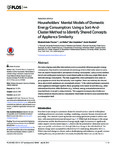Householders’ Mental Models of Domestic Energy Consumption: Using a Sort-And-Cluster Method to Identify Shared Concepts of Appliance Similarity
| dc.contributor.author | Gabe-Thomas, Elizabeth | |
| dc.contributor.author | Walker, I | |
| dc.contributor.author | Verplanken, B | |
| dc.contributor.author | Shaddick, G | |
| dc.date.accessioned | 2016-10-03T08:52:04Z | |
| dc.date.available | 2016-10-03T08:52:04Z | |
| dc.date.issued | 2016-07-28 | |
| dc.identifier.issn | 1932-6203 | |
| dc.identifier.issn | 1932-6203 | |
| dc.identifier.other | ARTN e0158949 | |
| dc.identifier.uri | http://hdl.handle.net/10026.1/5539 | |
| dc.description.abstract |
If in-home displays and other interventions are to successfully influence people's energy consumption, they need to communicate about energy in terms that make sense to users. Here we explore householders' perceptions of energy consumption, using a novel combination of card-sorting and clustering to reveal shared patterns in the way people think about domestic energy consumption. The data suggest that, when participants were asked to group appliances which they felt naturally 'went together', there are relatively few shared ideas about which appliances are conceptually related. To the extent participants agreed on which appliances belonged together, these groupings were based on activities (e.g., entertainment) and location within the home (e.g., kitchen); energy consumption was not an important factor in people's categorisations. This suggests messages about behaviour change aimed at reducing energy consumption might better be tied to social practices than to consumption itself. | |
| dc.format.extent | e0158949-e0158949 | |
| dc.format.medium | Electronic-eCollection | |
| dc.language | en | |
| dc.language.iso | en | |
| dc.publisher | Public Library of Science (PLoS) | |
| dc.subject | Adult | |
| dc.subject | Aged | |
| dc.subject | Cluster Analysis | |
| dc.subject | Electricity | |
| dc.subject | Female | |
| dc.subject | Humans | |
| dc.subject | Male | |
| dc.subject | Middle Aged | |
| dc.subject | Models, Psychological | |
| dc.title | Householders’ Mental Models of Domestic Energy Consumption: Using a Sort-And-Cluster Method to Identify Shared Concepts of Appliance Similarity | |
| dc.type | journal-article | |
| dc.type | Journal Article | |
| plymouth.author-url | https://www.webofscience.com/api/gateway?GWVersion=2&SrcApp=PARTNER_APP&SrcAuth=LinksAMR&KeyUT=WOS:000381516100016&DestLinkType=FullRecord&DestApp=ALL_WOS&UsrCustomerID=11bb513d99f797142bcfeffcc58ea008 | |
| plymouth.issue | 7 | |
| plymouth.volume | 11 | |
| plymouth.publication-status | Published | |
| plymouth.journal | PLOS ONE | |
| dc.identifier.doi | 10.1371/journal.pone.0158949 | |
| plymouth.organisational-group | /Plymouth | |
| plymouth.organisational-group | /Plymouth/Faculty of Health | |
| plymouth.organisational-group | /Plymouth/Users by role | |
| dc.publisher.place | United States | |
| dcterms.dateAccepted | 2016-06-26 | |
| dc.identifier.eissn | 1932-6203 | |
| dc.rights.embargoperiod | Not known | |
| rioxxterms.versionofrecord | 10.1371/journal.pone.0158949 | |
| rioxxterms.licenseref.uri | http://www.rioxx.net/licenses/all-rights-reserved | |
| rioxxterms.licenseref.startdate | 2016-07-28 | |
| rioxxterms.type | Journal Article/Review | |
| plymouth.oa-location | http://journals.plos.org/plosone/article?id=10.1371/journal.pone.0158949 |


